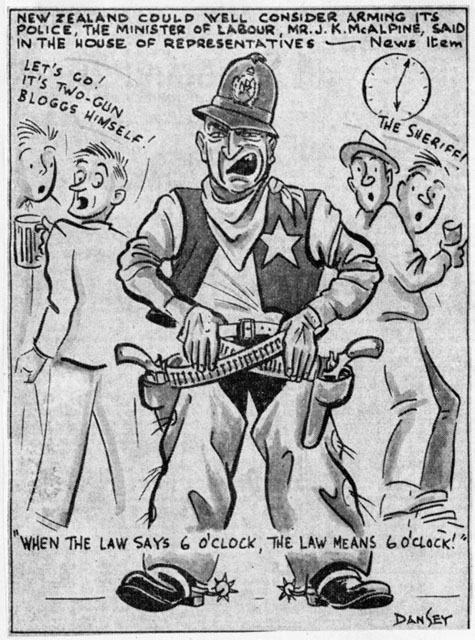Harry Dansey (1 November 1920 – 6 November 1979) was a born in Auckland and moved as a young boy with his family to Rotorua where he lived until the outbreak of World War Two. Dansey's mother who had received schooling in England and France gave him a love of poetry and reading while Dansey's father instilled in him an interest in Māori culture and lore through tales of Taniwha and Tohunga. During the war Dansey was a member of the 28th (Māori) Battalion stationed in Eygpt, North Africa, and Italy. While in the latter two countries Dansey was employed as an advance scout, sketching buildings and landscape, to provide intelligence information. Dansey, holding the rank of Sergeant, was discharged from the Army in 1946.
After the War Dansey settled with his family in Hawera where he completed a journalism apprenticeship with the Hawera Star. During the fifties Dansey worked as an editor, journalist and cartoonist for the Rangitikei News in Marton and subsequently the Taranaki Daily News in New Plymouth. Sixty of Dansey's cartoons featured in the Taranaki Daily News between 1956 - 1958 were collected in a book, Cartoons on international Affairs, published in 1958. Dansey's first book, How the Maoris came to Aotearoa, was published in 1947 although he had illustrated books prior to this such as Enid Tapsell's Historic Maketu : Hui Hui Mai! published by the Rotorua Morning Post in 1940.
In the sixties Dansey moved his family to Auckland where he worked as a journalist on the Auckland Star. During this time Dansey also spent time abroad lecturing and studying indigenous peoples. In the seventies Dansey left the Star to work as a freelance journalist. Dansey also entered local politics serving the Auckland City Council from 1971-1977.
In 1974 Dansey was appointed as New Zealand’s second race relations conciliator. Dansey was tasked with investigating complaints, his goal to affirm and promote racial
harmony and equality in New Zealand. Dansey held the belief that New Zealand society would develop its own
culture, drawing from the strengths of both Māori and Europeans. He wrote 'Of Two Races' for Te Ao Hou (a bilingual quarterly published by the Māori Affairs Department) on the developing population of mixed race New Zealander's drawing upon his own background,
"I am proud of the blood of both races which has been handed down to me from European and Maori ancestors"
Read Dansey's full article 'Of Two Races' here.
Dansey Illustrations accompanying this post are from the book How the Maoris Came, written by A.W. Reed, published in 1956.
Examples of Dansey's cartoons for the Taranaki Daily News.
Sources: H. R. Dansey and Te Rina Dawn Dansey. 'Dansey, Harry Delamere Barter', from the Dictionary of New Zealand Biography. Te Ara - the Encyclopedia of New Zealand, updated 1-Sep-10 http://www.TeAra.govt.nz/en/biographies/5d3/1/2.
Dansey, Harry Delamere Barter, 1920-1979. Dansey, Harry Delamere Barter, 1920-1979 :[John Marshall becoming Prime Minister] 7 September 1957, "You must realise, son, that there's no sentiment in business - except when it suits us." Taranaki Daily News, 25 March, 1958, New Zealand could well consider arming its police, the Minister of Labour, Mr J.K. McAlpine, said in the House of Representatives - News item'. "When the law says 6 o'clock, the law means 6 o'clock!" "Let's go! It's two-gun Bloggs himself!" "The sheriff!" The Taranaki News, 6 September, 1957. [Various cartoonists including Sir Gordon Minhinnick 1902-1992] :[Newspaper clippings of cartoons from New Zealand newspapers. 15 December 1948 to 5 September 1972.]. Ref: E-549-q-09-049. Alexander Turnbull Library, Wellington, New Zealand. http://natlib.govt.nz/records/22349604, http://natlib.govt.nz/records/22906920
Dansey, Harry Delamere Barter, 1920-1979. Dansey, Harry Delamere Baxter, 1920-1979 :I think I'll take my name off the Maori roll! Taranaki Daily News, 27 August 1956.. Ref: J-065-068. Alexander Turnbull Library, Wellington, New Zealand. http://natlib.govt.nz/records/23170659
All images 2013 © Estate of Harry D. B. Dansey
























































